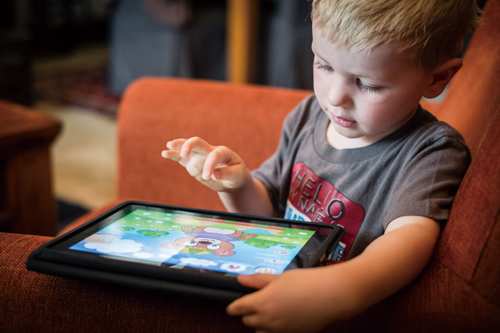Now that school is back in session, many families will be struggling to balance screen time at home. Lots of kids would happily while away the hours in a zombie-like trance, bathed in the twilight glow of a flickering screen, but the evidence overwhelmingly suggests that moderation, supervision, quality, and cooperative engagement are key when it comes to balancing screen time. Screen time is defined as the time spent using screens such as computers, televisions, video games, and digital handheld devices.
Every year, the figures for “total hours watched” continue to rise, and there’s a yawning chasm between expert recommendations and actual viewing patterns. Psychologist Dr. Aric Sigman recently published an influential review on the effects of screen time on children around the world. He found that, by the time the average child turns 18, they will have watched the equivalent of three years of continuous, 24/7 screen media. To make sense of it all, we examine official recommendations, weigh the pros and cons of screen time, and speak to two Beijing families about their philosophies of tech-in-action.
Listed opposite are just a few of the pros and cons of screen time, which families may want to consider before setting out their own rules.
Pros:
Trained Brain: A series of recent studies found that playing video games can have a positive impact on concentration and decision-making skills. While gaming, kids receive instant reinforcement and reward for focusing on a task and making quick decisions.
Box-ing Clever: TV can be both an effective entertainer and educator. Shows like Sesame Street and Blue’s Clues revolutionized children’s television. Limited co-viewing of these programs with parents can have positive learning effects. In his book The Tipping Point, Malcolm Gladwell credits these educational TV shows with creating a learning epidemic in preschoolers. Kids may love Elmo and Blue, but the shows are painstakingly and scientifically designed to direct their attention toward the real star – learning.
Better Hand-Eye Coordination: Multiple studies have shown that playing video games that require finely-tuned spatial skills go on to build hand-eye coordination and manual dexterity away from the screen.
Big Mother: Installing GPS tracking software on children’s phones is a growing trend. There are many free apps available
to turn your child’s smart phone into a device locator. Even if they forget to text or call, you can still track of their whereabouts. Check out free apps Securafone, Life360, or SMS Tracker (available for both Android and iPhone).
Tech to Teach: In traditional education, students learned what the teacher had to teach. Technology has advanced student-centered learning and served as the catalyst for an educational revolution. In today’s classrooms, teachers are using technology to drive dialogical learning and facilitate self-directed research. For today’s digital natives (the kids who’ve grown up swiping and typing), self-directed learning is as automatic and reflexive as breathing.
Cons:
Shoddy Body: Quality kids’ TV shows encourage movement and console makers have released active games for Wii and Xbox Kinect, but screen time generally leaves kids slumped in one position for hours. Sedentary behavior increases the prevalence of obesity and disturbed sleep.
I Don’t Think You’re Ready for this Telly: The average American child consumes three to four hours of TV and five to seven hours of screen time in total every day. Excessive TV, particularly on weekdays, can lead to worsened school performance. The problems are compounded for the 70 percent of American children who have a TV in their bedrooms (Kaiser Family Foundation, 2010). These kids watch more TV and more violent programming each day, as bedroom viewing tends to be unsupervised. No wonder these little tykes suffer from nightmares and disordered sleep!
Damaged Eyes and Hands: In addition to the obesity risk, there are other screen-specific ill effects to beware of, such as eye strain, and repetitive stress injuries such as carpal tunnel syndrome and iPad finger.
Big Brother: Kids who grew up on the web may think nothing of tweeting their every thought. However, a recent Kaplan Test Prep survey confirmed that over 25 percent of university admission officials investigate applicants online. Some students have even had their college offers revoked due to inappropriate remarks. Students need to be aware of and manage their digital footprint appropriately.
A Web of Lies: When a deadline is looming, many students resort to plagiarism. The Internet makes it too easy for students to copy and paste vast chunks of text or pay for a professionally-written term paper. According to the Ad Council and Educational Testing Service, over 75 percent of college cheaters admitted they began cutting corners in high school. If students plagiarize their way through, they miss out on developing vital critical analysis and writing skills.

What Do Experts Say?
In a study published earlier this year, Northwestern University revealed that most parents not only ignore guidelines on screen time, but are not generally concerned about media use. Given the widespread incidence of excessive screen time and its
potentially damaging effects on health and learning, it’s clear that there is a major breakdown in communication between parents and experts.
So what are considered safe guidelines? For starters, the American Academy of Pediatrics recommends that:
Bedrooms and dining tables remain screen-free zones. No TV, computers or video games allowed.
Children over 2 should be limited to no more than two hours of non-school related media per day. Kids learn best by engaging with activities in the real world, such as simply playing and exploring with friends and family.
Children under 2 should completely avoid TV and other entertainment media. Instead, lavish your little ones with human interaction. That initial period of face-to-face learning and communication is critical for their development into a healthy human being.
Parenting 2.0
Even with these guidelines, it can be difficult to figure out how to put it all together. To find out how real families deal with screen time, we spoke to two tech-savvy Beijing parents about their cyber house rules: Silas Newland and Rebecca Taylor.
The Newland Family
Silas Newland: The kids and I are dual US/Canada citizens and Erica is a US citizen. We’ve lived in Beijing almost two years. Erica works for Intel and I work for Morris Williams, a real estate company based in the US. Both Kylie (11) and Lance (9) attend the International Montessori School of Beijing.
What part does screen time play in your family?
Except on trips longer than 1.5 hours and the odd family movie night, screen time almost exclusively centers on dedicated eReaders such as our Nooks by Barnes & Noble. In the evenings, we play board games, read together, take the dog for a walk, or go for a bike ride. Lance is learning how to code via a program called Small Basic. Both kids enjoy making stop-motion movies and using Microsoft Movie Maker to edit and produce. They’ve made countless Lego movies and scrolling-captures where drawings are wound from one reel to another – think a rocket ship traveling through the galaxy.
Do you restrict screen time?
We have read many studies that link brain development with the absence of digital media, so having a strict electronics policy from day one was pretty obvious. The children share a computer specifically for school work. Our youngest has access from 4pm to 6pm each day; the oldest gets an additional hour. The Internet is monitored and filtered by McAfee. No games, chat rooms, YouTube, [and the like]can be accessed during those times. In our house, the Internet is for academic endeavors only!
We also worry what the kids might come across online; even innocuous search terms can return very disturbing results! We mitigate the risk by keeping the PC in a common area. I also monitor their apps. I can see everything that’s downloaded, so there’s no possibility of downloading new apps without my knowledge.
Do your kids have a TV in their bedroom?
No one in the family has a TV in the bedroom, as we think it creates too much focus on television and makes it harder to manage screen time.
Do you experience conflict with your children over screen time?
We have been using the same methods for a few years now and there are no conflicts about the rules. Although we can limit screen time at our house, it is impossible to manage it at other people’s homes, and we know we will have still less control as they mature. But if we’ve done our job right, they will make good choices whether we are there or not.
How was your childhood different from your kids’ when it comes to screen time?
Growing up in Vermont, I lived between mountains that blocked all television reception, and my childhood tech revolved around the sole PC that my school had available to the students.
Are there benefits to exposing kids to technology at a young age?
Technology is everywhere and very easy to interact with. Our children have plenty of exposure to “screen time” through school and our limited allowance. I don’t believe there’s any risk that tech-light kids will be left behind. If we create a love of learning, then children will embrace technology at the right time as an additional tool.
The Taylor Family
Rebecca Taylor: We’re an Australian family beginning our fifth year in Beijing. Doug is one of the elementary technology integrators at the Western Academy of Beijing; I am an elementary teacher currently working from home promoting my online children’s shoe business and finishing my Master’s of Teacher Librarianship. We have two kids: son Will (4) and daughter Charlotte (1). Will attends WAB.
What part does screen time play in your family?
We never put the TV on at home unless we’re watching sports as a family. Instead, we ride our bikes, do puzzles, read a lot, and most of all engage in imaginative play. We believe that the family that plays together stays together! We also watch DVDs once a week; often, it’s Thomas the Tank Engine – Will’s favorite. Will also loves the tactile, interactive nature of the iPad. He usually makes a movie every weekend with his dad Doug, which can take two to three hours.
Do you restrict screen time?
At Will’s age, under an hour of screen time is plenty; for Charlotte, there is none. We also avoid using electronic devices at meal times. At restaurants, we take a “restaurant bag,” which has toys, books, and play dough inside. We limit screen time rigorously because I see how zoned-out Will becomes after 30 minutes. His body and brain need stimulation, especially physical movement, and screen time reduces that considerably. When Will is over-engaged in tech, he’s not aware of his surroundings, he can’t hear us when we talk to him, he loses track of time, and he sometimes even forgets to go to the toilet.
Do your kids have a TV in their bedroom?
I am passionately against TVs in the bedroom. There’s so much crap out there that is absolutely unsuitable for kids. Why risk exposing them to sex and violence when they really don’t need to see it? I am even more passionately against bedroom computers. The net is so full of predators and unsuitable content. Children need our guidance to navigate all the muck.
Do you experience conflict with your children over screen time?
Not currently, as they are simply too young. But the situation may change as they get older and peer pressure gets stronger. I hope that by discussing with them the rights and responsibilities they have as members of our family and of the community, they learn to value the concept of balance.
How was your childhood different from your kids’ when it comes to screen time?
What screen time? We watched the occasional movie and some cartoons on weekend mornings. I didn’t use a computer consistently until I left home to board for Grade 11 and 12. I didn’t even have a cell phone till the ripe old age of 21!
Are there benefits of exposing kids to technology at a young age?
Purposeful, supervised technology can be exciting, educational and fun – a great springboard into the plugged-in world. But it’s critical that tech is about creation, not just consumption. Creative technology could potentially transform society with communal wisdom and global change. Tech can be used for harm but, overwhelmingly, it can be used for social good. It’s up to parents and educators to guide kids through the information maze, and open them up to the wider world.
Resources
1. Books
Boys Adrift by Leonard Sax
Examines the correlation between screen time and underachieving young men.
Screen Time by Lisa Guernsey
Recommends that parents focus on “the three C’s”: content, context, and the individual child.
The Winter of Our Disconnect by Susan Maushart
A mother of three teenage kids pulls the plug on family tech and reaps the benefits in better communication.
2. Websites
www.letsmove.gov/reduce-screen-time-and-get-active
Advice on screen time from US First Lady Michelle Obama’s program to tackle childhood obesity.
Recommended Apps for Learning
Pre-School and Kindergarten
1. Endless Alphabet
Monsters teach letters.
2. Bugs and Buttons
A wide range of mathematical and literacy games.
3. SquiggleFish
Draw and color fish to populate an aquarium.
Elementary
1. Book Creator
Make your own books.
2. Puppet Pals Directors Pass
Star in your own cartoon!
3. iMotion HD
Create stop motion or time lapse videos.
Middle and High School
1. Evernote
Take, store and share notes
2. Khan Academy
Thousands of videos on many subjects.
3. Studious
Plan your homework and exam prep.
Middle and High School
1. Evernote
Take, store and share notes
2. Khan Academy
Thousands of videos on many subjects.
3. Studious
Plan your homework and exam prep.
photos by Mitchell Pe Masilun
This article originally appeared on p56-61 of the beijingkids September 2013 issue.
Check out the PDF version online at Issuu.com




